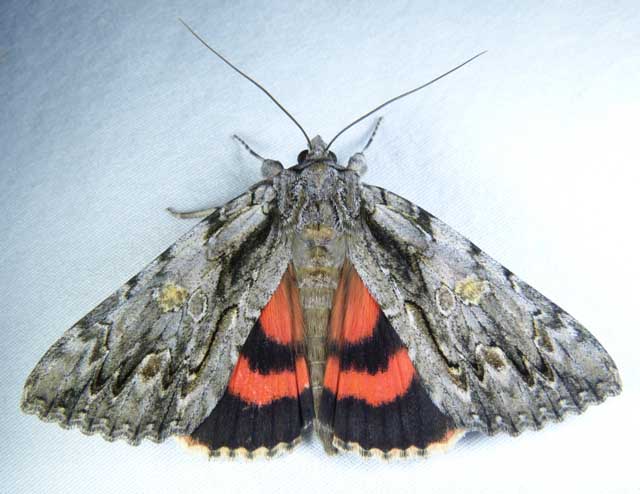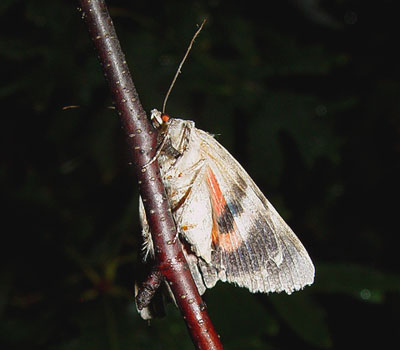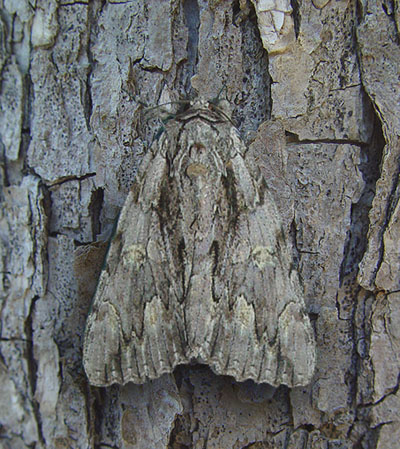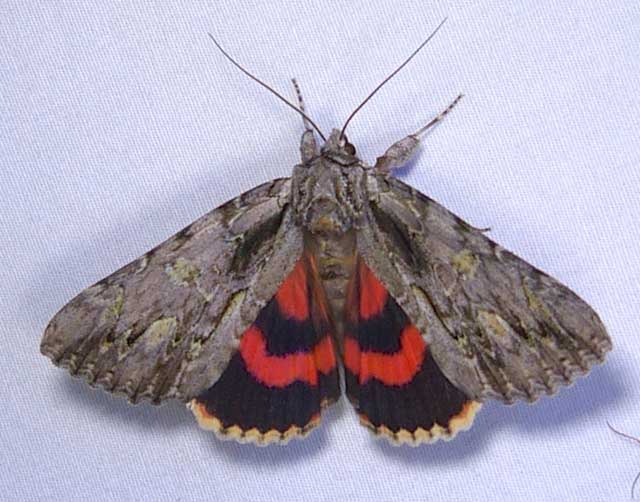Catocala coccinata
Catocala coccinata
kah-TOCK-uh-lahMkoss-sin-NAY-ta
Grote, 1872

Catocala coccinata male, courtesy of Vernon A. Brou.

Catocala coccinata, Buffalo County, Wisconsin,
July 13, 2014, courtesy or Marcie O'Connor
This site has been created by
Bill Oehlke.
Comments, suggestions and/or additional information are welcomed by Bill.
| TAXONOMY:
Superfamily: Noctuoidea
Family: Erebidae, Leach, [1815]
Subfamily: Erebinae, Leach, [1815]
Tribe: Catocalini, Boisduval, [1828]
Genus: Catocala, Schrank, 1802
|
DISTRIBUTION:
It has also been reported in
Arkansas,
Illinois,
Indiana,
Iowa,
Kansas,
Kentucky,
Louisiana,
Maine,
Maryland,
Massachusetts,
Michigan,
Minnesota,
Mississippi,
Missouri,
New Hampshire,
New York,
North Carolina,
Ohio,
Pennsylvania,
Rhode Island,
South Carolina,
Tennessee,
Virginia,
West Virginia and
Wisconsin.
The bright red/scarlet underwings distinguish this species. There are usually diffuse basal and anal dashes on an otherwise light grey, mottled forewing.
The hindwing fringe is white, checked, and sometimes has red highlights at apex. Tim Dyson verso image (right), Peterborough, Ontario, July 26, 2006.
| 
|
I was unaware of the amount of red on the forewing under surface until I saw the following rare image of the Scarlet Underwing in flight.

Catocala coccinata in flight, Peterborough, Ontario,
July 28, 2016, courtesy of Tim Dyson.

Catocala coccinata, Stillwater Township, Sussex County,
New Jersey
July 3, 2006, courtesy of Joe Garris.

Catocala coccinata, Stillwater Township, Sussex County,
New Jersey
July 3, 2006, courtesy of Joe Garris.
In examining the pm line on all species on this page, I find the "tooth" just below the pair of very elongated "teeth" is much
reduced and is quite rounded, usually allowing considerable room for a lighter patch of scales. There is a dark bar across the thorax.
The reniform spot tends be to light, often with a greenish cast to it. The Joe Garris image above also shows considerable salmon colouration
in fringe that is heavily checked.
 |
It is the flashy hindwings that really stand out. The forewings
offer excellent camouflage against tree bar, a common resting place.
Catocala coccinata on Bur Oak bark and above ventral image, Peterborough, Ontario,
courtesy of Tim Dyson.
Females deposit eggs in the crevices between the rough bark
sections. |

Catocala coccinata, Buffalo County, Wisconsin,
July 19 2014, courtesy or Marcie O'Connor
FLIGHT TIMES AND PREFERRED FOOD PLANTS:
Catocala coccinata are usually on the wing from June to
September.
Moths come to lights and also to bait.
The Catocala coccinata caterpillar feeds on oaks.

Catocala coccinata, Athol, Worcester County, Massachusetts,
July 28, 2011, courtesy of Dave Small.

Catocala coccinata, Athol, Worcester County, Massachusetts,
July 28, 2011, courtesy of Dave Small.
ECLOSION:
Adults eclose from pupae at soil surface.
Catocala coccinata females emit an airbourne pheromone and males use their antennae to track the scent plume.

Catocala coccinata, Cambridge, Maryland,
June 25, 2019, courtesy of Jonathan Willey.
EGGS, CATERPILLARS, COCOONS AND PUPAE:
Eggs are deposited on tree bark in the fall and hatch the following spring.
Larval Food Plants
Listed below are primary food plant(s) and alternate food plants.
It is hoped that this alphabetical listing followed by the common
name of the foodplant will prove useful. The list is not exhaustive,
although some species seem very host specific.
Experimenting with closely related foodplants is worthwhile.
Quercus bicolor
Quercus coccinea
Quercus ilicifolia
Quercus macrocarpa.......
Quercus rubra
Quercus stellata
|
Swamp White oak
Scarlet oak
Bear/Scrub oak
Bur oak
Northern Red oak
Post oak
|
Return to Main Index
This page is brought to you by Bill Oehlke and the
WLSS. Pages are on space rented from Bizland. If you would like
to become a "Patron of the Sphingidae/Catocala Sites",
contact Bill.
Please send sightings/images to Bill. I will do my best to respond to requests for identification help.
Enjoy some of nature's wonderments, giant silk moth cocoons.
These cocoons are for sale winter and fall. Beautiful Saturniidae moths will emerge the following spring and summer.
Read Actias luna rearing article.
Additional online help available.
Eggs of many North American Saturniidae species are offered during the spring and summer. Occasionally
summer Actias luna and summer Antheraea polyphemus cocoons are available. Shipping to US destinations is done
from within the US.
Use your browser "Back" button to return to the previous page.










